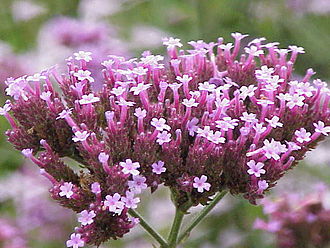Verbena

Verbena (/vərˈbiːnə/,[3] vervain) is a genus in the family Verbenaceae. It contains about 150 species of annual and perennial herbaceous or semi-woody flowering plants. The majority of the species are native to the Americas and Asia. Verbena officinalis, the common vervain or common verbena, is the type species and native to Europe.
The leaves are usually opposite, simple, and in many species hairy, often densely so. The flowers are small, with five petals, and borne in dense spikes. Typically some shade of blue, they may also be white, pink, or purple, especially in cultivars.
The genus can be divided into a diploid North American and a polyploid South American lineage, both with a base chromosome number of seven. The European species is derived from the North American lineage. It seems that verbena as well as the related mock vervains (Glandularia) evolved from the assemblage provisionally treated under the genus name Junellia; both other genera were usually included in the Verbenaceae until the 1990s.[4] Intergeneric chloroplast gene transfer by an undetermined mechanism – though probably not hybridization – has occurred at least twice from vervains to Glandularia, between the ancestors of the present-day South American lineages and once more recently, between V. orcuttiana or V. hastata and G. bipinnatifida. In addition, several species of verbena are of natural hybrid origin; the well-known garden vervain has an entirely muddy history. The relationships of this close-knit group are therefore hard to resolve with standard methods of computational phylogenetics.[5]
Some species, hybrids and cultivars of verbena are used as ornamental plants. They are drought-resistant, tolerating full to partial sun, and enjoy well-drained, average soils. Plants are usually grown from seed. Some species and hybrids are not hardy and are treated as half-hardy annuals in bedding schemes.[6]
They are valued in butterfly gardening in suitable climates, attracting Lepidoptera such as the Hummingbird hawk-moth, Chocolate albatross, or the Pipevine swallowtail, and also hummingbirds, especially V. officinalis, which is also grown as a honey plant.
The hybrid cultivars “Silver Anne”[7] and “Sissinghurst”[8] have gained the Royal Horticultural Society’s Award of Garden Merit.
Although verbena (“vervain”) has been used in herbalism and traditional medicine, usually as an herbal tonic, there is no high-quality evidence for its effectiveness.[9] Verbena has been listed as one of the 38 plants used to prepare Bach flower remedies,[10] a kind of alternative medicine promoted for its effect on health. According to Cancer Research UK, “essence therapists believe that using essences can help to increase your mental, emotional and spiritual wellbeing. However, essences are not used to prevent, control, or cure cancer or any other physical condition.”[11]
The essential oil of various species, mainly common vervain, is traded as “Spanish verbena oil”. Considered inferior[citation needed] to oil of lemon verbena (Aloysia citrodora) in perfumery,[9] it is of some commercial importance for herbalism.
